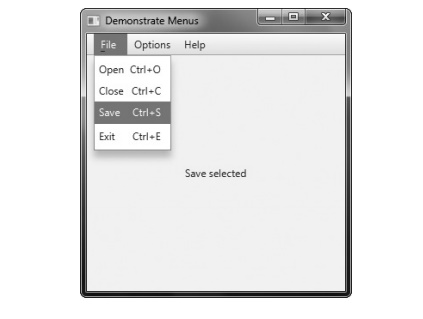Chapter: Java The Complete Reference : Introducing GUI Programming with JavaFX : Introducing JavaFX Menus
Add Mnemonics and Accelerators to Menu Items - JavaFX
Add
Mnemonics and Accelerators to Menu Items
The menu created in the
preceding example is functional, but it is possible to make it better. In real
applications, a menu usually includes support for keyboard shortcuts. These
come in two forms: accelerators and mnemonics. An accelerator is a key
combination that lets you select a menu item without having to first activate
the menu. As it applies to menus, a mnemonic defines a key that lets you select
an item from an active menu by typing the key. Thus, a mnemonic allows you to
use the keyboard to select an item from a menu that is already being displayed.
An accelerator can be
associated with a Menu or MenuItem. It is specified by calling setAccelerator( ), shown next:
final void
setAccelerator(KeyCombination keyComb)
Here, keyComb is the key combination that is pressed to select the menu
item. KeyCombination is class that
encapsulates a key combination, such as ctrl-s. It is packaged in javafx.scene.input.
KeyCombination defines two protected constructors,
but often you will use the
keyCombination( ) factory method, shown here:
static KeyCombination
keyCombination(String keys)
In this case, keys is a string that specifies the key
combination. It typically consists of a modifier, such as ctrl, alt, shift, or
meta, and a letter, such as s. There is a special value, called shortcut, which can be used to specify
the ctrl key in a Windows system and the meta key on a Mac. (It also maps to the typically used shortcut key on
other types of systems.) Therefore, if you want to specify ctrl-s as the key
combination for Save, then use the string "shortcut+S". This way, it
will work for both Windows and Mac and elsewhere.
The following sequence adds
accelerators to the File menu created by the MenuDemo program in the previous section. After making this change,
you can directly select a File menu option by pressing ctrl-o, ctrl-c, ctrl-s,
or ctrl-e.
// Add keyboard accelerators for the File menu.
open.setAccelerator(KeyCombination.keyCombination("shortcut+O"));
close.setAccelerator(KeyCombination.keyCombination("shortcut+C"));
save.setAccelerator(KeyCombination.keyCombination("shortcut+S"));
exit.setAccelerator(KeyCombination.keyCombination("shortcut+E"));
A mnemonic can be specified
for both MenuItem and Menu objects, and it is very easy to
do. Simply precede the letter in the name of the menu or menu item with an
underscore. For example, in the preceding example, to add the mnemonic F to the File menu, declare fileMenu as shown here:
Menu fileMenu = new Menu("_File"); //
now defines a mnemonic
After making this change, you
can select the File menu by typing alt then f. However, mnemonics are active
only if mnemonic parsing is true (as
it is by default). You can turn mnemonic parsing on or off by using setMnemonicParsing( ), shown here:
final void
setMnemonicParsing(boolean enable)
In this case, if enable is true, then mnemonic parsing is turned on. Otherwise, it is turned
off.
After making these changes,
the File menu will now look like this:

Related Topics